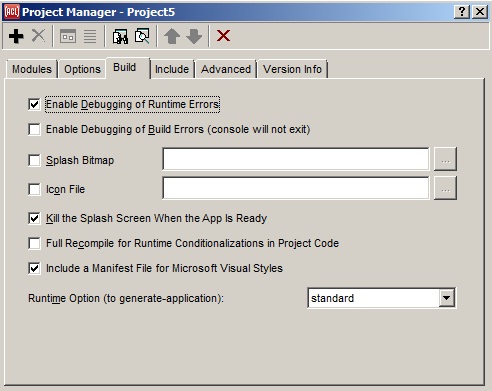
| Allegro CL version 9.0 Unrevised from 8.2 to 9.0. 8.2 version | ||||||||||

This tab on the Project Manager Dialog shows several options associated with building the application associated with the project. (Build an application with File | Build Project Executable, which builds a test version for use on your machine; or File | Build Project Distribution, which creates a directory of all files needed for the application, suitable for sending to another machine. See also build-project, which is a programmatic equivalent of the two menu commands. Be sure you are properly licensed before distributing an application to another machine.) Note the Help File widget, which has never been supported, has been removed in release 6.2.
The options are:
*show-console-on-standalone-error*
is true, as it is by default, then the console will also appear
automatically when an error is signaled and not trapped by the
application. The application's icon will also appear in the system
tray,
which may be
double-clicked to expose the console window if it does not appear for
some reason on an error, or to expose it when no error has occurred.
(If a standalone application stops responding entirely, it is a good
idea to double-click the tray icon to see if there is an error in the
console.)
Note that it is the Franz Liszt icon that is displayed. The application icon specified by the Icon File option is not used in the system tray.
When this option is selected, the symbol
:allow-runtime-debug will be included in the
build-flags of the project.
We recommend leaving this option checked for debugging purposes until shortly before delivering an application, and then turning the option off for delivery, to shield the end user from the debugging console and tray icon as well as from the possibility of continuing to use the application after an unhandled error. When this option is turned off and an unhandled error is signaled in the delivered application, the project's default-error-handler-for-delivery function (see the Advanced tab) will be called, where the default function will show a simple dialog informing the user that an unhandled error has occurred and that the application will now exit. The lisp error string is included in the dialog, but the end user is not allowed to continue running the application in its broken state. To make a Common Graphics application handle errors more cleanly, an application should add its own signal handlers (such as calls to handler-bind) around code that could possibly signal an error.
Note that it is the Franz Liszt icon that is displayed. The application icon specified by the Icon File option is not used in the system tray.
:interactive as the
build-debug keyword argument to generate-application. This allows debugging
in the lisp that was generating the app, but also means that the
console for that lisp will never exit, even when no build error
occurs. Therefore, this option is not selected by default, and you
would typically select it only if a build error has occurred, and then
try again. When this option is selected, the symbol
:allow-build-debug will be included in the build-flags of the project.
#-runtime-system or
#+runtime-system reader conditionalizations to make
the project behave somewhat differently when it is run as a standalone
application than when it is run in the IDE. See full-recompile-for-runtime-conditionalizations. If
checked, all project code will be recompiled with
:runtime-system included on the *features* list before a project
distribution is produced, as described on the full-recompile-for-runtime-conditionalizations
page.
:standard, :dynamic,
and :partners (and these are the three values for
this option). You must be licensed for whatever choice you make. See
runtime.htm for details. See also runtime-build-option.
See the general description of the Project Manager Dialog for details of the toolbar buttons.
Copyright (c) 1998-2019, Franz Inc. Oakland, CA., USA. All rights reserved.
This page was not revised from the 8.2 page.
Created 2012.5.30.
| Allegro CL version 9.0 Unrevised from 8.2 to 9.0. 8.2 version | ||||||||||